Scientists Detect a Massive Wave Rippling Through the Milky Way

Astronomers have uncovered something extraordinary — a colossal wave rippling through the Milky Way’s disk, moving outward from the galaxy’s center like a frozen ripple on water.
Using data from the European Space Agency’s Gaia space telescope, researchers discovered that this immense structure extends across tens of thousands of light-years, displacing stars above and below the plane of the galaxy. This finding shows that our galaxy is not a calm, static spiral but a dynamic, restless system still echoing from ancient cosmic events.
What Exactly Did Scientists Find?
The discovery comes from a new study titled “The Great Wave – Evidence of a Large-Scale Vertical Corrugation Propagating Outwards in the Galactic Disc”, led by Eloisa Poggio and her colleagues at Italy’s National Institute for Astrophysics (INAF). The research team analyzed data from Gaia, which maps the positions and movements of more than a billion stars in our galaxy with unparalleled precision.
They found that the Milky Way’s disk — the flat region where most of its stars reside — isn’t just warped (which was already known) but also hosts a wave-like motion traveling outward. This wave displaces stars both above and below the galactic mid-plane, forming a vast “corrugation” that stretches across roughly 30,000 to 65,000 light-years from the galactic center.
To understand how big that is, remember that the Milky Way itself spans about 100,000 light-years in diameter. So, this wave covers a huge fraction of the galaxy.
How Gaia Helped Reveal the Great Wave
Gaia’s mission is to measure the three-dimensional positions and velocities of stars. It doesn’t just show where stars are but also how they’re moving — whether toward us, away from us, or sideways across the sky. This allows scientists to make detailed maps of the Milky Way’s structure and motion in 6D (three spatial dimensions plus three velocity components).
By examining the motions of young giant stars and Cepheid variable stars (which are excellent distance markers because their brightness varies in a predictable way), Poggio’s team could trace how these stars move across the galactic disk.
These two stellar groups — about 17,000 young giants and 3,400 Cepheids — revealed a consistent, large-scale pattern: a wave-like vertical motion across the disk. In some regions, stars were moving upward relative to the galactic plane; in others, they were moving downward. When plotted, these vertical displacements formed a rhythmic pattern, just like a wave frozen in motion.
The Scale and Structure of the Wave
The “Great Wave” isn’t a minor wiggle. The vertical amplitude — the distance stars move above or below the plane — reaches about 150 to 200 parsecs (roughly 500 to 650 light-years). It extends across a radial zone between 10,000 and 14,000 parsecs (around 30,000 to 45,000 light-years) from the galactic center.
Interestingly, the wave appears to be propagating outward, not just standing still. The data show that stars’ vertical motions (their velocity “up” or “down”) are slightly shifted in phase compared to their vertical positions — meaning the motion leads the displacement. This is exactly what scientists would expect from a traveling wave rather than a stationary bend.
This isn’t just theory — Gaia’s velocity data clearly show patterns of motion consistent with a moving wave. The team even found that the wave affects stars in different galactic quadrants, suggesting it’s a global feature, not a localized disturbance.
Visualizing the Galactic Wave
When viewed from “above,” the Milky Way’s disk looks like a flat spiral. But from the side, it’s clear that one half of the disk curves upward while the other curves downward — this is the warp, known for decades. On top of that warp, Gaia has now revealed a giant ripple superimposed on the structure.
In visualizations from ESA, the red regions mark where stars lie above the plane, and the blue regions show where they lie below it. White arrows illustrate how the stars move. These arrows don’t perfectly align with the color pattern — instead, they’re shifted — which is the fingerprint of a true wave traveling through the disk.
What Could Have Caused It?
The origin of this galactic wave remains a mystery. Several theories are on the table:
- A past collision with a smaller galaxy — The Milky Way has been shaped by mergers and collisions throughout its history. One strong candidate is the Sagittarius Dwarf Galaxy, a small satellite galaxy currently being torn apart by our galaxy’s gravity. Its repeated passages through the Milky Way’s disk could have triggered massive ripples.
- Disturbances in the Milky Way’s dark matter halo — The dark matter surrounding our galaxy could fluctuate, and those gravitational changes might shake the disk like a drum.
- Internal processes — Spiral arms, the galactic bar, or even the distribution of gas and dust could create oscillations that propagate across the disk.
Right now, researchers can’t say for sure which explanation fits best. But the outward propagation and the fact that young stars participate suggest it’s a relatively recent event — perhaps a few hundred million years old in galactic timescales.
Why Young Stars Matter
Young stars, especially Cepheids, are particularly valuable for this kind of study because they haven’t had much time to drift from where they were born. Their motions still preserve the signature of the conditions in the gas clouds that formed them.
That means the gas itself in the Milky Way’s disk is likely participating in this wave. If that’s true, the ripple isn’t just a stellar phenomenon — it’s a large-scale oscillation of both stars and interstellar gas. This idea could reshape how astronomers think about star formation and gas dynamics in the galaxy.
How This Differs from Other Galactic Ripples
You might have heard of the Radcliffe Wave, a smaller, nearby structure of star-forming gas extending across about 9,000 light-years near the Sun. While it’s also a wave-like feature, it’s much smaller and located in a different region of the Milky Way.
The new “Great Wave” is vastly larger, stretching across tens of thousands of light-years in the outer disk, far beyond the Sun’s orbit. The two waves might not be related, but studying both could help astronomers understand whether such ripples are common in galactic disks or the result of specific collisions.
The Broader Picture: The Milky Way’s Shape Is Not Simple
For decades, astronomers assumed the Milky Way was a barred spiral galaxy with a modest warp. But Gaia’s detailed measurements are painting a much more complex and dynamic picture.
- The disk is warped, wobbly, and now rippled.
- Stellar motions reveal ongoing disturbances.
- Even the Sun itself sits on a slightly tilted orbit — not perfectly aligned with the galactic mid-plane.
These features suggest the Milky Way is still settling after billions of years of cosmic interactions. The galaxy is effectively “ringing” like a bell struck long ago, and we’re living inside that ongoing vibration.
Why This Discovery Matters
This discovery does more than add a curiosity to galactic maps — it changes how scientists model the Milky Way’s mass distribution and gravitational potential.
Vertical waves in the stellar disk can reveal how mass (including dark matter) is spread throughout the galaxy. The way stars move up and down depends directly on the strength of gravity at different locations. So, by mapping the wave, astronomers gain new tools to measure both visible and invisible matter.
It also helps refine simulations of galaxy evolution. The Milky Way serves as a nearby laboratory for understanding how galaxies form, merge, and stabilize over billions of years. Discovering such a massive, coherent wave implies that galactic disks are far more active than once thought.
What Comes Next
The Gaia mission is far from over. Its fourth data release (DR4) is expected to provide even more precise positions, motions, and brightness data for hundreds of millions of stars, including variable stars like Cepheids. With these data, astronomers will be able to:
- Map the wave’s shape and amplitude in even finer detail.
- Search for similar waves in other parts of the disk.
- Compare the stellar motion maps with gas maps (from radio telescopes observing hydrogen and molecular clouds) to see if the gas follows the same ripple pattern.
- Run computer simulations to test different causes, such as collisions or spiral-arm resonances.
This ongoing research could ultimately reveal when and how the wave started, and what it says about the Milky Way’s recent history.
Learning More About Galactic Dynamics
Understanding the Milky Way’s motion isn’t just about mapping stars — it’s about decoding the forces that shape galaxies everywhere.
Waves and warps like this are common in many spiral galaxies. Astronomers have seen similar ripples in galaxies such as NGC 4565 and IC 2233, but seeing it from the inside — in our own galaxy — is much harder. Gaia’s unique ability to chart stellar motion in 3D gives us a view of the Milky Way’s inner heartbeat for the first time.
The study also connects to broader questions in astrophysics:
- How do galaxies interact with their smaller companions?
- How long do waves like this persist?
- Can such waves trigger new bursts of star formation as gas clouds get compressed and rarefied?
Each of these questions is now open for exploration.
The Milky Way: Still Evolving
Despite being 13 billion years old, the Milky Way isn’t done changing. It’s continuously influenced by smaller galaxies, dark matter, and its own internal processes. The Great Wave is another reminder that our galaxy is alive and in motion, filled with patterns and structures that tell the story of its past encounters.
Every star we see in the night sky is part of this vast, vibrating system. Thanks to Gaia, we can finally start to watch those vibrations unfold — one wave at a time.
Research Reference:
Poggio, E., Khanna, S., Drimmel, R., Zari, E., D’Onghia, E., Lattanzi, M. G., Palicio, P. A., Recio-Blanco, A., & Thulasidharan, L. (2025). The Great Wave – Evidence of a Large-Scale Vertical Corrugation Propagating Outwards in the Galactic Disc. Astronomy & Astrophysics. https://doi.org/10.1051/0004-6361/202451668





